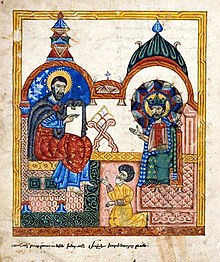| Revision as of 07:55, 7 June 2007 editDbachmann (talk | contribs)227,714 editsNo edit summary← Previous edit | Revision as of 09:45, 7 June 2007 edit undoFolantin (talk | contribs)Autopatrolled, Extended confirmed users, Pending changes reviewers, Rollbackers27,187 edits See talk pageNext edit → | ||
| Line 1: | Line 1: | ||
| ] | ] | ||
| '''Moses of Chorene''' (] {{lang|hy|Մովսէս Խորենացի}} ''Movsēs Xorenac‘i, Movses Khorenats'i'') (traditionally fl. 5th century AD |
'''Moses of Chorene''' (] {{lang|hy|Մովսէս Խորենացի}} ''Movsēs Xorenac‘i, Movses Khorenats'i'') (traditionally fl. 5th century AD) is traditionally regarded as the author of the most significant mediaeval Armenian history. He is credited with the earliest known historiographical work on Armenia, but is also known as a ], or ], and a ]. | ||
| ==Life== | ==Life== | ||
| Line 20: | Line 20: | ||
| ===''History''=== | ===''History''=== | ||
| {{main|History of Armenia (Moses of Chorene)}} | {{main|History of Armenia (Moses of Chorene)}} | ||
| Moses is considered to be the "father of Armenian history" (''patmahayr''). It is uncertain whether the work as preserved is correctly attributed to him, and in part appears to date |
Moses is considered to be the "father of Armenian history" (''patmahayr''). It is uncertain whether the work as preserved is correctly attributed to him, and in part appears to date from some time after the 7th century.<ref>Robert K. Thomson, "Armenian Literary Culture through the Eleventh Century", in R.G. Hovahanissian (ed.), ''Armenian People from Ancient to Modern Times''(Volume 1, 2004)</ref> It covers the time-frame from the formation of the ] to the 5th century. | ||
| ==References== | ==References== | ||
Revision as of 09:45, 7 June 2007

Moses of Chorene (Armenian Մովսէս Խորենացի Movsēs Xorenac‘i, Movses Khorenats'i) (traditionally fl. 5th century AD) is traditionally regarded as the author of the most significant mediaeval Armenian history. He is credited with the earliest known historiographical work on Armenia, but is also known as a poet, or hymn writer, and a grammarian.
Life
A native of the village of Khorni in the province of Taron, when young, he was sent by Mesrop, the founder of Armenian literature, to study in Edessa, Constantinople, Alexandria, Athens, and Rome. Upon his return, he is said to have assisted Mesrop (407-433), in the translation of the Bible into Armenian.
Works
The following works are attributed to Moses:
- History of Armenia
- Treatise on Rhetoric
- Treatise on Geography
- Letter on the Assumption of the Blessed Virgin Mary
- Homily on Christ's Transfiguration
- Oration on Hripsime, an Armenian Virgin and Martyr
- Hymns used in Armenian Church Worship
- Commentaries on the Armenian Grammarians
- Explanations of Armenian Church Offices
History
Main article: History of Armenia (Moses of Chorene)Moses is considered to be the "father of Armenian history" (patmahayr). It is uncertain whether the work as preserved is correctly attributed to him, and in part appears to date from some time after the 7th century. It covers the time-frame from the formation of the Armenian people to the 5th century.
References
- Robert K. Thomson, "Armenian Literary Culture through the Eleventh Century", in R.G. Hovahanissian (ed.), Armenian People from Ancient to Modern Times(Volume 1, 2004)
External links
- Movses of Chorene, "The History of Armenia" (In Russian)